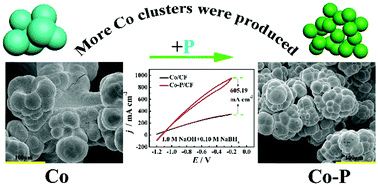A three-dimensional porous Co–P alloy supported on a copper foam as a new catalyst for sodium borohydride electrooxidation
Abstract
Cobalt has been extensively studied as an effective catalyst for the electrooxidation of sodium borohydride. However, there is still the problem of the low catalytic activity of cobalt catalysts. The improvement in the catalytic activity of cobalt for the electrooxidation of sodium borohydride has become a challenge. In this paper, a novel catalyst Co–P alloy was supported on a copper foam (CF) substrate by a one-step electrodeposition method. In the electrodeposition process, a Co–P/CF electrode with a three-dimensional (3D) porous structure was successfully prepared using hydrogen bubbles as a dynamic template. Through the physical characterization of Co–P/CF, it was proven that the doping of P element produced more Co clusters on the surface of the electrode, which resulted in more active sites. These characteristics were very beneficial for NaBH4 electrooxidation. The electrochemical characterization confirmed that the electrocatalytic activity of Co–P/CF for NaBH4 was better than that of Co/CF. At room temperature, for the Co–P/CF in 2.0 mol dm−3 NaOH + 0.20 mol dm−3 NaBH4 solution, the oxidation current density reached 1795 mA cm−2 at −0.20 V (vs. Ag/AgCl), which was higher than that previously reported the literature.



 Please wait while we load your content...
Please wait while we load your content...